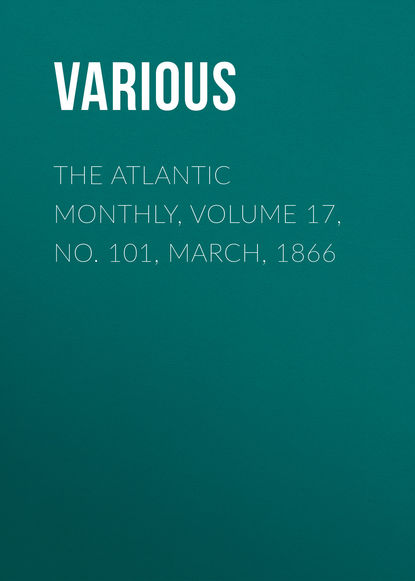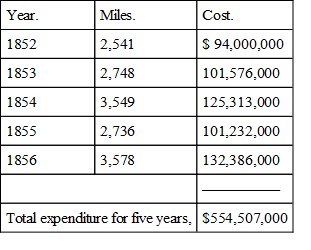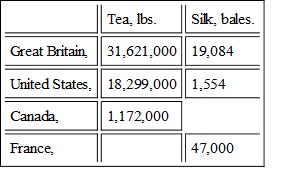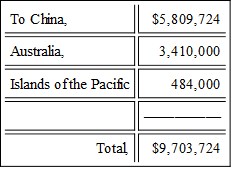 Полная версия
Полная версияThe Atlantic Monthly, Volume 17, No. 101, March, 1866
"The great depots for building material exist principally in the mountain sections, but the plains on either side are not destitute in that particular. All through the Bitter Root and Rocky Mountains, the finest white and red cedar, white pine, and red fir that I ever have seen are found."12
GEOLOGICAL FEATURES
The geological formation of the heart of the continent promises to open a rich field for scientific exploration and investigation. The Wind River Mountain, which divides the Yellow Stone from the Great Basin, is a marked and distinct geological boundary. From the northern slope flow the tributaries of the Yellow Stone, fed by springs of boiling water, which perceptibly affect the temperature of the region, clothing the valleys with verdure, and making them the winter home of the buffalo,—the favorite hunting-grounds of the Indians,—while the streams which flow from the southern slope of the mountains are alkaline, and, instead of luxuriant vegetation, there are vast regions covered with wild sage and cactus. They run into the Great Salt Lake, and have no outlet to the ocean. A late writer, describing the geological features of that section, says:—
"Upon the great interior desert streams and fuel are almost unknown. Wells must be very deep, and no simple and cheap machinery adequate to drawing up the water is yet invented. Cultivation, to a great extent, must be carried on by irrigation."13
Such are the slopes of the mountains which form the rim of the Great Basin, while the valley of the Yellow Stone is literally the land which buds and blossoms like the rose. The Rosebud River is so named because the valley through which it meanders is a garden of roses.
And here, along the head-waters of the Yellow Stone and its tributaries, at the northern deflection of the Wind River chain of mountains, flows a river of hot wind, which is not only one of the most remarkable features of the climatology of the continent, but which is destined to have a great bearing upon the civilization of this portion of the continent. St. Joseph in Missouri, in latitude 40°, has the same mean temperature as that at the base of the Rocky Mountains in latitude 47°! The high temperature of the hot boiling springs warms the air which flows northwest along the base of the mountains, sweeping through the Big Hole Pass, the Deer Lodge, Little Blackfoot, and Mullan Pass, giving a delightful winter climate to the valley of the St. Mary's, or Bitter Root. It flows like the Gulf Stream of the Atlantic. Says Captain Mullan: "On its either side, north and south, are walls of cold air, and which are so clearly perceptible that you always detect the river when you are on its shores."14
This great river of heat always flowing is sufficient to account for the slight depth of snow in the passes at the head-waters of the Missouri, which have an altitude of six thousand feet. The South Pass has an altitude of seven thousand eight hundred and eighty-nine feet. The passes of the Wasatch Range, on the route to California, are higher by three thousand feet than those at the head-waters of the Missouri, and, not being swept by a stream of hot air, are filled with snows during the winter months. The passes at the head-waters of the Saskatchawan, in the British possessions, though a few hundred feet lower than those at the head-waters of the Missouri, are not reached by the heated Wind River, and are impassable in winter. Even Cadotte's Pass, through which Governor Stevens located the line of the proposed road, is outside of the heat stream, so sharp and perpendicular are its walls.
Captain Mullan says: "From whatsoever cause it arises, it exists as a fact that must for all time enter as an element worthy of every attention in lines of travel and communication from the Eastern plains to the North Pacific."15
DISTANCES
That this line is the natural highway of the continent is evident from other considerations. The distances between the centres of trade and San Francisco, and with Puget Sound, will appear from the following tabular statement:—
Approximate Distances

P Hall's Guide,—via Omaha, Denver, and Salt Lake.
The line to Puget Sound will require no tunnel in the pass of the Rocky Mountains. The approaches of the Big Hole and Deer Lodge in both directions are eminently feasible, requiring little rock excavation, and with no grades exceeding eighty feet per mile.
All of the places east of the latitude of Chicago, and north of the Ohio River, are from three hundred to five hundred and fifty miles nearer the Pacific at Puget Sound than at San Francisco,—due to greater directness of the route and the shortening of longitude. These on both lines are the approximate distances. The distance from Puget Sound to St. Louis is estimated—via Desmoines—on the supposition that the time will come when that line of railway will extend north far enough to intersect with the North Pacific.
COST OF CONSTRUCTION
The census of 1860 gives thirty thousand miles of railroad in operation, which cost, including land damages, equipment, and all charges of construction, $37,120 per mile. The average cost of fifteen New England roads, including the Boston and Lowell, Boston and Maine, Vermont Central, Western, Eastern, and Boston and Providence, was $36,305 per mile. In the construction of this line, there will be no charge for land damages, and nothing for timber, which exists along nearly the entire line. But as iron and labor command a higher price than when those roads were constructed, there should be a liberal estimate. Lieutenant Mullan, in his late Report upon the Construction of the Wagon Road, discusses the probability of a railroad at length, and with much ability. His highest estimate for any portion of the line is sixty thousand dollars per mile,—an estimate given before civilization made an opening in the wilderness. There is no reason to believe that this line will be any more costly than the average of roads in the United States.
In 1850 there were 7,355 miles of road in operation; in 1860, 30,793; showing that 2,343 miles per annum were constructed by the people of the United States. The following table shows the number of miles built in each year from 1853 to 1856, together with the cost of the same.

This exhibit is sufficient to indicate that there need be no question of our financial ability to construct the road.
In 1856, the country had expended $776,000,000 in the construction of railroads, incurring a debt of about $300,000,000. The entire amount of stock and bonds held abroad at that time was estimated at only $81,000,000.16
AID FROM GOVERNMENT
The desire of the people for the speedy opening of this great national highway is manifested by the action of the government, which, by act of Congress, July 2, 1864, granted the alternate sections of land for twenty miles on each side of the road in aid of the enterprise. The land thus appropriated amounts to forty-seven million acres,—more than is comprised in the States of New Hampshire, Vermont, Massachusetts, and New York! If all of these lands were sold at the price fixed by government,—$2.50 per acre,—they would yield $118,000,000,—a sum sufficient to build and equip the road. But years must elapse before these lands can be put upon the market, and the government, undoubtedly, will give the same aid to this road which has already been given to the Central Pacific Road, guaranteeing the bonds or stock of the company, and taking a lien on the road for security. Such bonds would at once command the necessary capital for building the road.
THE WESTERN TERMINUS
Puget Sound, with its numerous inlets, is a deep indentation of the Pacific coast, one hundred miles north of the Columbia. It has spacious harbors, securely land-locked, with a surrounding country abounding in timber, with exhaustless beds of coal, rich in agricultural resources, and with numerous mill-streams. Nature has stamped it with her seal, and set it apart to be the New England of the Pacific coast.
That portion of the country is to be peopled by farmers, mechanics, and artisans. California is rich in mineral wealth. Her valleys and mountain-slopes yield abundant harvests; but she has few mill-streams, and is dependent upon Oregon and Washington for her coal and lumber. An inferior quality of coal is mined at Mount Diablo in California; but most of the coal consumed in that State is brought from Puget Sound. Hence Nature has fixed the locality of the future manufacturing industry of the Pacific. Puget Sound is nearer than San Francisco, by several hundred miles, to Japan, China, and Australia. It is therefore the natural port of entry and departure for our Pacific trade. It has advantages over San Francisco, not only in being nearer to those countries, but in having coal near at hand, which settles the question of the future steam marine of the Pacific.
Passengers, goods of high cost, and bills of exchange, move on the shortest and quickest lines of travel. No business man takes the way-train in preference to the express. Sailing vessels make the voyage from Puget Sound to Shanghai in from thirty to forty days. Steamers will make it in twenty.
TRADE WITH ASIA
Far-seeing men in England are looking forward to the time when the trade between that country and the Pacific will be carried on across this continent. Colonel Synge, of the Queen's Royal Engineers, says:—
"America is geographically a connecting link between the continents of Europe and Asia, and not a monstrous barrier between them. It lies in the track of their nearest and best connection; and this fact needs only to be fully recognized to render it in practice what it unquestionably is in the essential points of distance and direction."17
Another English writer says:—
"It is believed that the amount of direct traffic which would be created between Australia, China, and Japan, and England, by a railway from Halifax to the Gulf of Georgia, would soon more than cover the interest upon the capital expended.... If the intended railway were connected with a line of steamers plying between Victoria (Puget Sound), Sydney, or New Zealand, mails, quick freight, passengers to and from our colonies in the southern hemisphere, would, for the most part, be secured for this route.
"Vancouver's Island is nearer to Sydney than Panama by nine hundred miles; and, with the exception of the proposed route by a Trans-American railway, the latter is the most expeditious that has been found.
"By this interoceanic communication, the time to New Zealand would be reduced to forty-two, and to Sydney to forty-seven days, being at least ten less than by steam from England via Panama."18
Lord Bury says:—
"Our trade [English] in the Pacific Ocean with China and with India must ultimately be carried through our North American possessions. At any rate, our political and commercial supremacy will have utterly departed from us, if we neglect that great and important consideration, and if we fail to carry out to its fullest extent the physical advantages which the country offers to us, and which we have only to stretch out our hands to take advantage of."19
Shanghai is rapidly becoming the great commercial emporium of China. It is situated at the mouth of the Yangtse-Kiang, the largest river of Asia, navigable for fifteen hundred miles. Hong-Kong, which has been the English centre in China, is nine hundred and sixty miles farther south.
With a line of railway across this continent, the position of England would be as follows:—

Mr. Maciff divides the time as follows by the Puget Sound route:—

The voyage by Suez is made in the Peninsular and Oriental line of steamers. The passage is proverbially comfortless,—through the Red Sea and Persian Gulf, across the Bay of Bengal, through the Straits of Malacca, and up the Chinese coast, under a tropical sun. Bayard Taylor thus describes the trip down the Red Sea:—
"We had a violent head-wind, or rather gale. Yet, in spite of this current of air, the thermometer stood at 85° on deck, and 90° in the cabin. For two or three days we had a temperature of 90° to 95°. This part of the Red Sea is considered to be the hottest portion of the earth's surface. In the summer the air is like that of a furnace, and the bare red mountains glow like heaps of live coals. The steamers at that time almost invariably lose some of their firemen and stewards. Cooking is quite given up."20
Bankok, Singapore, and Java can be reached more quickly from England by Puget Sound than by Suez.
Notwithstanding the discomforts of the passage down the Red Sea, the steamers are always overcrowded with passengers, and loaded to their utmost capacity with freight. The French line, the Messageries Imperials de France, has been established, and is fully employed. Both lines pay large dividends.
The growth of the English trade with China during the last sixteen years has been very rapid. Tea has increased 1300 per cent, and silk 950.21
The trade between the single port of Shanghai and England and America in the two great staples of export is seen from the following statement of the export of tea and silk from that port from July 1, 1859, to July 1, 1860:—

The total value of exports from England to China in 1860 was $26,590,000. Says Colonel Sykes:—
"Our trade with China resolves itself into our taking almost exclusively from them teas and raw silk, and their taking from us cotton, cotton yarns, and woollens."22
The exports of the United States to the Pacific in 1861 were as follows:—

By the late treaty between the United States and China, that empire is thrown open to trade; and already a large fleet of American-built steamers is afloat on the gleaming waters of the Yang-tse. Mr. Burlingame, our present Minister, is soon to take his departure for that empire, with instructions to use his utmost endeavor to promote friendly relations between the two countries. That this country is to have an immense trade with China is evident from the fact that no other country can compete with us in the manufacture of coarse cotton goods, which, with cotton at its normal price, will be greatly sought after by the majority of the people of that country, who of necessity are compelled to wear the cheapest clothing.
Shanghai is the silk emporium of the empire. A ton of silk goods is worth from ten to fifteen thousand dollars. Nearly all of the silk is now shipped by the Peninsular and Oriental line, at a charge of $125 to $150 per ton; and notwithstanding these exorbitant rates, Shanghai merchants are compelled to make written application weeks in advance, and accept proportional allotments for shipping. In May, 1863, the screw-steamer Bahama made the trip from Foochow to London in eighty days with a cargo of tea, and obtained sixty dollars per ton, while freights by sailing vessels were but twenty dollars; the shippers being willing to pay forty dollars per ton for forty days' quicker delivery. With the Northern Pacific line constructed, the British importer could receive his Shanghai goods across this continent in fifty days, and at a rate lower than by the Peninsular line.
The route by the Peninsular line runs within eighty miles of the Equator; and the entire voyage is through a tropical climate, which injures the flavor of the tea. Hence the high price of the celebrated "brick tea," brought across the steppes of Russia. The route by Puget Sound is wholly through temperate latitudes, across a smooth and peaceful sea, seldom vexed by storms, and where currents, like the Gulf Stream of Mexico, and favoring trade-winds, may be taken advantage of by vessels plying between that port and the Asiatic coast.
Japan is only four thousand miles distant from Puget Sound. The teas and silks of that country are rapidly coming into market. Coal is found there, and on the island of Formosa, and up the Yang-tse.
CLIMATE
The climate of Puget Sound is thus set forth by an English writer, who has passed several months at Victoria:—
"From October to March we are liable to frequent rains; but this period of damp is ever and anon relieved by prolonged intervals of bright dry weather. In March, winter gives signs of taking its departure, and the warm breath of spring begins to cover the trees with tinted buds and the fields with verdure.... The sensations produced by the aspects of nature in May are indescribably delightful. The freshness of the air, the warbling of birds, the clearness of the sky, the profusion and fragrance of wild roses, the widespread, variegated hues of buttercups and daisies, the islets and violets, together with the distant snow-peaks bursting upon the view, combine in that month to fill the mind with enchantment unequalled out of Paradise. I know gentlemen who have lived in China, Italy, Canada, and England; but, after a residence of some years in Vancouver Island, they entertained a preference for the climate of the colony which approached affectionate enthusiasm."23
The climate of the whole section through which the line passes is milder than that of the Grand Trunk line. The lowest degree of temperature in 1853—54 at Quebec was 29 below zero; Montreal, 34; St. Paul, 36; Bitter Root Valley, forty miles from Big Hole Pass, 20.
In 1858 a party of Royal Engineers, under Captain Pallissir, surveyed the country of the Saskatchawan for a line to Puget Sound which should lie wholly within the British possessions. They found a level and fertile country, receding to the very base of the mountains, and a practicable pass, of less altitude than those at the head-waters of the Missouri; but in winter the snow is deep and the climate severe. That section of Canada north of Superior is an unbroken, uninhabitable wilderness. The character of the region is thus set forth by Agassiz. He says:—
"Unless the mines should attract and support a population, one sees not how this region should ever be inhabited. Its stern and northern character is shown in nothing more clearly than in the scarcity of animals. The woods are silent, and as if deserted. One may walk for hours without hearing an animal sound; and when he does, it is of a wild and lonely character.... It is like being transported to the early ages of the earth, when mosses and pines had just begun to cover the primeval rock, and the animals as yet ventured timidly forth into the new world."24
THE FUTURE
The census returns of the United States indicate that, thirty-four years hence, in the year 1900, the population of this country will exceed one hundred millions. What an outlook! The country a teeming hive of industry; innumerable sails whitening the Western Ocean; unnumbered steamers ploughing its peaceful waters; great cities in the unexplored solitudes of to-day; America the highway of the nations; and New York the banking-house of the world!
This is the age of the people. They are the sovereigns of the future. It is the age of ideas. The people of America stand on the threshold of a new era. We are to come in contact with a people numbering nearly half the population of the globe, claiming a nationality dating back to the time of Moses. A hundred thousand Chinese are in California and Oregon, and every ship sailing into the harbor of San Francisco brings its load of emigrants from Asia. What is to be the effect of this contact with the Orient upon our civilization? What the result of this pouring in of emigrants from every country of the world,—of all languages, manners, customs, nationalities, and religions? Can they be assimilated into a homogeneous mass? These are grave questions, demanding the earnest and careful consideration of every Christian, philanthropist, and patriot. We have fought for existence, and have a name among the nations. But we have still the nation to save. Railroads, telegraphs, steamships, printing-presses, schools, platforms, and pulpits are the agents of modern civilization. Through them we are to secure unity, strength, and national life. Securing these, Asia may send over her millions of idol-worshippers without detriment to ourselves. With these, America is to give life to the long-slumbering Orient.
So ever toward the setting sun the course of empire takes its way,—not the empire of despotism, but of life, liberty,—of civilization and the Christian religion.
IN THE SEA
The salt wind blows upon my cheekAs it blew a year ago,When twenty boats were crushed amongThe rocks of Norman's Woe.'Twas dark then; 't is light now,And the sails are leaning low.In dreams, I pull the sea-weed o'er,And find a face not his,And hope another tide will beMore pitying than this:The wind turns, the tide turns,—They take what hope there is.My life goes on as thine would go,With all its sweetness spilled:My God, why should one heart of twoBeat on, when one is stilled?Through heart-wreck, or home-wreck,Thy happy sparrows build.Though boats go down, men build anew,Whatever winds may blow;If blight be in the wheat one year,We trust again and sow,Though grief comes, and changesThe sunshine into snow.Some have their dead, where, sweet and soon,The summers bloom and go:The sea withholds my dead,—I walkThe bar when tides are low,And wonder the grave-grassCan have the heart to grow!Flow on, O unconsenting sea,And keep my dead below;Though night—O utter night!—my soul,Delude thee long, I know,Or Life comes or Death comes,God leads the eternal flow.THE CHIMNEY-CORNER FOR 1866
III
IS WOMAN A WORKER?
"Papa, do you see what the Evening Post says of your New-Year's article on Reconstruction?" said Jennie, as we were all sitting in the library after tea.
"I have not seen it."
"Well, then, the charming writer, whoever he is, takes up for us girls and women, and maintains that no work of any sort ought to be expected of us; that our only mission in life is to be beautiful, and to refresh and elevate the spirits of men by being so. If I get a husband, my mission is to be always becomingly dressed, to display most captivating toilettes, and to be always in good spirits,—as, under the circumstances, I always should be,—and thus 'renew his spirits' when he comes in weary with the toils of life. Household cares are to be far from me: they destroy my cheerfulness and injure my beauty.
"He says that the New England standard of excellence as applied to woman has been a mistaken one; and, in consequence, though the girls are beautiful, the matrons are faded, overworked, and uninteresting; and that such a state of society tends to immorality, because, when wives are no longer charming, men are open to the temptation to desert their firesides, and get into mischief generally. He seems particularly to complain of your calling ladies who do nothing the 'fascinating lazzaroni of the parlor and boudoir.'"
"There was too much truth back of that arrow not to wound," said Theophilus Thoro, who was ensconced, as usual, in his dark corner, whence he supervises our discussions.
"Come, Mr. Thoro, we won't have any of your bitter moralities," said Jennie; "they are only to be taken as the invariable bay-leaf which Professor Blot introduces into all his recipes for soups and stews,—a little elegant bitterness, to be kept tastefully in the background. You see now, papa, I should like the vocation of being beautiful. It would just suit me to wear point-lace and jewelry, and to have life revolve round me, as some beautiful star, and feel that I had nothing to do but shine and refresh the spirits of all gazers, and that in this way I was truly useful, and fulfilling the great end of my being; but alas for this doctrine! all women have not beauty. The most of us can only hope not to be called ill-looking, and, when we get ourselves up with care, to look fresh and trim and agreeable; which fact interferes with the theory."



